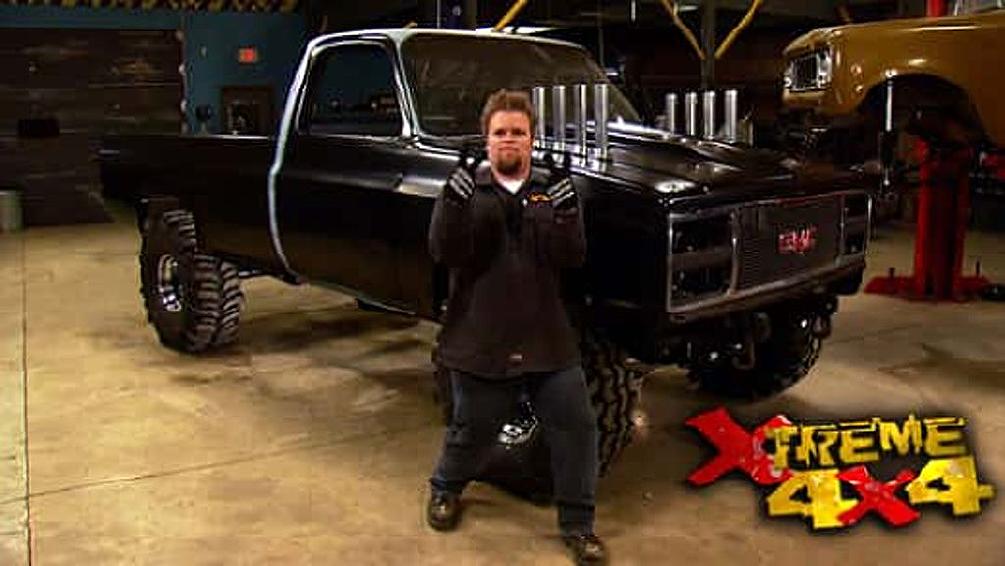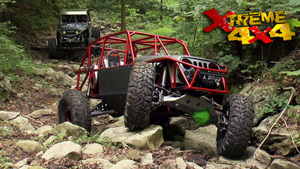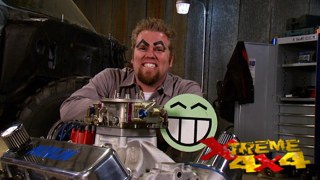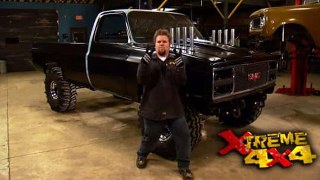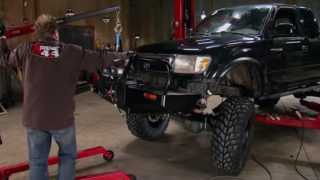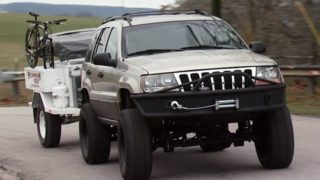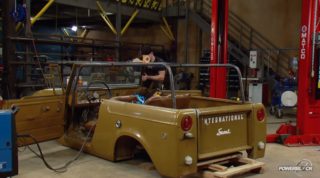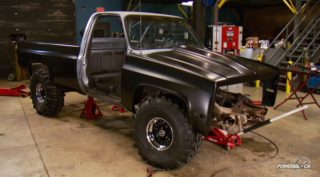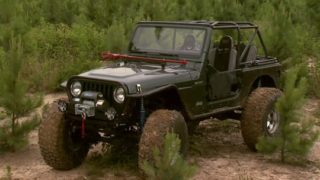More Mud Truck Episodes
Xtreme 4x4 Builds
Want more content like this?
Join the PowerNation Email NewsletterParts Used In This Episode
Auto Meter
5" Pro-Comp single range 0-9000 rpm tachometer, Pro-Comp liquid filled mechanical water temperature and oil pressure guages.
CTM Racing Products
CTM U-Joints.
Interco Tire Co.
15/39.5-15 Super Swamper TSL, 18/39.5-15 Super Swamper Bogger.
LMC Truck
Rear spring hangers, door shell rh and lh, front fender lh and rh, cowl induction hood steel, grille and radiator support, 8 ft. bedsides lh and rh.
Randy's Ring & Pinion
Yukon 9.0" HD 3.250" Race Nodular iron dropout housing case. Yukon high performance spool, 5.13 gearset, Oversize aluminum pinion support, billet yoke, complete bearing and shim kit.
Rough Country Suspension Systems
Front leaf springs, u-bolts, polyurethane bushings, 4 Rough Country Nitro 9000 series shocks, rear springs and installation hardware.
Spidertrax
All Spider 9 Axle Housings are 65" long (plenty of axle tube to cut to size) and are available with forward engine third member orientation or mid-engine third member orientation (as used in mid-engine competition rock crawlers). All housings are designed to work with Ford 9" style third members. The Spidertrax 1 Ton Full Floater End Cup Kit makes it easy to build your Spider 9 Housing into a competition grade full floating rear axle. Each cup is designed to press fit onto the Spider 9 housing w
Spidertrax
All Spider 9 Axle Housings are 65" long (plenty of axle tube to cut to size) and are available with forward engine third member orientation or mid-engine third member orientation (as used in mid-engine competition rock crawlers). All housings are designed to work with Ford 9" style third members. The Spidertrax 1 Ton Full Floater End Cup Kit makes it easy to build your Spider 9 Housing into a competition grade full floating rear axle. Each cup is designed to press fit onto the Spider 9 housing w
Episode Transcript
Why won't the Dana 44 work for our mud truck. What is an anti wrap bar? How do you make your own bead locks on the cheap? Those questions answer. Plus what's with the dirt diet? The Xtreme 4x4 starts. Now.
Now a mud bog race truck truly is the quarter mile dragster of the off road world. You simply take an old truck strip as much weight off of it as you can put as much horsepower under the hood as your wallet can handle and then tear off through either a pit or a bog. The truck that makes the trip, the
asked us after a day of racing is considered the winner. Now, what makes an off road mud bog truck work? Well, is a lot different than what makes a trail truck or a rock crawler work well, and today we're going to spend some time dealing with those details. But before we tear into our 87 Chevy, let's go ahead and have a look back to where this all began.
Ever since extreme hit the air. Mud,
Boers have been begging for a truck build up. So we picked up a worn out 87 pickup and stripped it bare
gutted some stock panels and built a roll cage. At
the same time, the horsepower guys put together a killer 588 cubic inch 800 horsepower big block monster.
After bolting up a set of zoomies
added a suspension lift. We installed a bomb proof rear axle to handle the power
and a set of 39.5 Interco Boer
Swampers.
Then we had a killer looking mud truck.
Now, considering the last time we saw this truck, it was sitting on four tires. I'm sure you're wondering where the front axle went. Now, we had to make a change of plans with this project. We originally dreamt up this idea. We were gonna have a stroke 400 small block under the hood, but the guys at horsepower put together this monster 588 which isn't a bad idea. This is a great motor for mud racing. The downfall is, is it's more power than we planned for. So we had to re evaluate some things. The main thing being our front axle,
the Dana 44 that we had underneath this truck would not survive at all with that much power pushing it. We would have invested in shafts and a drive shaft and setting it all up and we probably would have made one pass and it would have been destroyed and we'd be changing it.
So this is the type of thing you got to look at when you make a major change in your project. So, what we've done is we've taken it out. We've ordered a complete spider tracks unit to match our rear axle and that can handle the power. Now, speaking of our rear axle, first thing we're going to do today is deal with the traction issue.
Recently, we had one of the tech inspectors from the mud racing association come in, have a look at our truck and determine what class we would be competing in. They told us we're probably gonna land in either a super stock or a modified super stock. And that is because we still have leaf springs on all four corners. And the nice thing about that class is it's very competitive. We should be able to do very well.
Now, the downfall to sticking with the lease springs is that we're gonna have a lot of axle wrap. Now that means when we turn on the power of that 588 this housing is actually gonna turn right on its own axis that can put our U joint in a bind and possibly cause our drive shaft to break. So we're gonna build an anti wrap bar. Now to do that, we need to design it in a very specific way.
The track bar will stop the housing from twisting because we'll have a mount on the top and the bottom side of the housing it will travel up to the truck's frame. And when we mounted at the truck's frame, we need to have a swing shackle or a pivot point so the tire can still move through its natural suspension movement. If we just had a solid mount up there, the axle would be solid mounted and we wouldn't be able to have the leaf spring move up and down. Now, this is a perfect example of how we're gonna build it differently because it's a mud truck. If it was a trail truck, we want
hem joints everywhere. But on the mud truck, we're just gonna put one at the front mount so we can adjust it back here at the axle. We're just gonna use standard leaf spring bushings, they're perfectly strong and they're a lot cheaper.
We use a piece of scrap axle tube to simulate the axle underneath the truck
and we will lay out the mounts for both ends of our torque bar and measure for some tubing.
The main support tube will be in and three quarter quarter inch wall dom.
Once we have it cut
and not,
we could tack it together on the bench.
We'll slide it under the truck for a trial fit.
We'll cut an inch and three quarter hole into the side of our truck's frame
and add a bushing for the swing shackle,
pull it out and fully weld it.
Finally, torque arm is installed under the truck.
Now, there's a couple different types of mud racing and we're building our truck to compete in both. There's pit racing, which is usually pretty quick. You're at the end of the track in about 3 to 5 seconds. But bog racing, that's a deep sloppy mud hole that you throw the whole truck in and you're just churning the tires at full throttle for sometimes up to five minutes for that. We're going to need a good cooling system. So we're gonna go ahead and install
these universal fit all aluminum radiators from summit racing. Now, this is a two core radiator which will aid in cooling. The all aluminum design will help dissipate the heat a little bit better than a plastic and copper style. Now, we're going to be putting it in the bed of the truck to keep it out of the way of debris churned up from the front tires. We'll need an electric fan. So we're going to install this Hayden 16 inch unit right on the back.
The radiator mount will be built using some small three quarter inch electric weld tubing.
Once it's fully welded,
we'll bolt up our radiator,
install the fans
and mount it in the bed of the truck on some small tabs.
Now, to get the coolant from our motor back to our rear mounted radiator, we're gonna be using a moroso big block Chevy electric water pump. Let's do a couple of things for us. We have no belts on the front of our motor that can get kicked off when we're at full throttle.
And number two, we can cool our motor. Even when the engine switches off, the truck is sitting in the pits, the electric water pump will circulate 19 cubic feet per minute of water through the radiator and then back up into the block to keep it cool. Now, to move the water, we're going to be using a simple exhaust tubing inch and a half an inch and three quarter and some off the shelf, rubber elbows
up next. There's more to crafting a mud course than just water and dirt. We'll learn the technology of mud making when Xtreme 4x4 continues.
Welcome back to Xtreme 4x4 where we're putting the finishing touches on our 800 horsepower mud truck. Now, believe it or not, just as much care and concern goes into building a competitive mud racing course and the key ingredient to that. Well, it's right here.
Louisiana, red Clay.
Oh, it's so good. I
just take
it
Sunday mud races aren't just an event. They're a Louisiana tradition
ever since you're
like five years old. You've grown up around the mud ride and all that drawing thousands of Spectators and hundreds of racers. There's no better place to hold a mud race than Monroe's Twin City Speedway. I would have to say this is my favorite track. The track out here is one of the best tracks on the circuit. If you want my opinion on it. During the race weekend, teams were working hard to prep their rigs. Ken Barry was not only focused on his truck
but also on his race track. Oh, yeah, I love mud racing, that's for sure.
After competing on substandard tracks,
Ken decided four years ago to build a mud only speedway. You know, that was part of the reason for building and starting to do these type races is giving people a place to go and actually take their four wheel drive truck and uh, racing to create and maintain the top track on the circuit
isn't an overnight endeavor. He just can't own a piece of land, bulldoze a lane and say, ok, I have a mud racing track. It's not that simple from the floor
but deep mud hole to the perfectly grated horseshoe.
Everything about this place is pro, it's a real good track. They do a lot of uh prep work, clean it up real good. Get ready to write for some
while in the planning phase, Ken's main focus was on finding the best mud compound. You actually do have to learn the tight mud that you're bailing for you. He passed on the native gumbo dirt and trucked in tons of the finest
Louisiana red flag. And as you can see, you know, you can't do anything with gumbo. It just balls up and continues to get hard
with this sandier clay,
you know, will break up, you know, it does not become a, a ball where your gumbo mud, the more mud, the more water you put to it.
You know, the more gummier it can become springing faster speeds and improved times. The red clay has become the turf of choice. It's like grease slicky, but it's not sticky. Red clay
on this track. This makes it, uh, for a faster race, the speed is greater. Then when you have Gumbo, you bog down more and it's not as fast. And the races out here all looking for speed, months of track prep all come down to race day. But for Ken there don't let up,
you know, the day of the race, I have very little time to go around and socialize and those type things. By mid race, there was a broken track side sprinkler
system is down right now and we are doing a little, uh
we pray in here, but we're about to get it back together and a steady stream of fires to put out. So this race is for
1st and 3rd.
Now this play, this race right here is for third,
ok?
And then if carter cannot make the call, then
the way it ought to be,
you know, I've had people actually go, boy, he's an ass, you know,
uh he won't even, you know, he won't even stop and talk to you. It's a constant battle. Believe me, come tomorrow, it'll be
uh uh starts about seven o'clock
in the morning. For me and ends about nine o'clock tomorrow night. His day is long but when it's time to strap into the modified, it's all worth it.
Oh, any time you mount up that truck at heart gets pound and that extra energy comes, you know, that is the whole thrill behind it all. Look is to strap down behind 1000 horsepower and go around this four mile
but truck.
It's his love of the mud that has earned Ken Berry the respect of his bud brethren. My hat's off to him for working hard and you know, putting a lot of his personal time and money to this deal and we wouldn't be where we're at today. Most of these guys do gripe at me sometimes, but most the largest majority of them appreciate what we do and that's why I keep doing it.
Build on a budget Xtreme 4x4 projects that save you time and money.
A bead lock rim will keep the tire from coming off the rim when it's aired down on the trail to get over those obstacles. Now, the downfall is they can be fairly expensive and quite an investment. But if you have an old steel rim like this one here, you can build your own bead locks with a do it yourself bead lock kit. Now, the nice thing about this is you can build four bead locks for the price of one brand new one.
It starts by welding an inner ring right onto the outer bead lip of your rim.
I like to use a tig welder because you can keep an eye on the molten puddle and usually eliminate any pinholes
coat
of paint on the rim. And the new outer ring
toss a tire on it
and we just have to bolt it up
and that's all it takes to have a great looking and more importantly, great working bead lock all for just about 60 bucks a tire.
We're back on extreme with our mud truck and its last day in the shop before we take it out, throw it into some deep sloppy hole and try our hand at mud
bogging. Now, originally, we planned to rebuild the Dano 44 that was underneath this truck from the factory with some upgraded shafts. When we saw the dyno numbers from that big block, we got a little scared and decided the best thing to do would be to replace
it with a spider tracks spider nine front end assembly to match the one that we swapped into the rear and you'll notice something different on the housing and that spider tracks. Now will weld these inner knuckles on for you? All you have to do is give them the total measurement of the axle as well as your caster angle. They'll jig it all up, weld it completely. All you have to do is bolt it under your rig,
the housing under the truck and bolted up to the leaf springs, we can begin to assemble the ultimate knuckles.
Spider track knuckles use spherical rod bearings instead of oe
style ball joints.
A serious upgrade for hardcore off roading.
One of the nice things about ordering the pre welded housing is spider trash can cut your axle shaft at the same time
and we're assembling ours with some CTMU joints.
The unit bearings are modified from Ford F 450 pickups
machine to accept the spider tracks drive plans
to complete our front axle. We're going to need a gear set as well as a third member. So I went ahead and put together this matching unit to the one that we assembled for the rear axle. This is all brand new parts from Randy's Ring and pin
and it starts with their heavy duty nodular
housing with these extra ribs to add strength. One of their heavy duty P
supports men to build aluminum to eliminate gear deflection as well as a billet yoke. Now, inside, we have a set of 5, 13 years mounted onto a spool. Now, this is where we're a little bit different was because we're building a mud truck and not a trail truck. If we put this much of an investment into a trail truck, we would want a locker in that front end. We were out,
drive on the trail need to make those tight turns and want to be able to unlock the front axle. So each wheel turns independently, but because we're building a mud
Boer, we want all four wheels to have max power at all times. So the spool will help us do that. Now, the nice thing about using a nine inch is if you're not comfortable setting up a gear set for the first time, you can go ahead and buy a complete dropout. Third member from Randy's, it'll come preassembled, set up. All you got to do is bolt it in.
Where are you?
We're back in the extreme shop. We've got our drive train completely dialed in on our mud truck and we're confident it's gonna be able to handle the pit. We throw this truck in now, we can take care of some of the little things we're gonna start with the doors. We originally planned to just cover this opening with some sheet metal, but instead we opted for a complete replacement door that we got from L MC truck. Now, the nice thing about this is we weighed it. It comes in at less than 30 pounds. Plus we'll be able to use the factory hinges up front. We'll just close it up,
weld the seam in the rear. When we're ready for the track,
the engine under the hood of this truck is a serious investment. We want to keep an eye on it when we're tearing through the mud. So we're going to install three gauges to do that all from auto meter, an auto meter. Monster tack will keep track of the engine's RPM. The shift light that we can program will keep us from over
that engine and causing damage. Now, these two smaller two and 58 of an inch gauge are definitely overkill for a trail truck, but perfect for our mud bogg. These are a mechanical liquid filled gauge. Now, the liquid
face means that when the trucks bounce in through the mud, the gauge isn't bouncing around giving us a bad reading. It would be a nice fluid stroke. Now, mechanical means that it actually has an oil line hooked up to the back of it. Now, the reason that is important because if we were out in the mud had a while, water splash up underneath the hood, it could short out an electric sender would read zero. We'd shut the truck down thinking that we had a problem only to find out later that it was just an electrical issue, not an engine problem with mechanical gauges. We have a perfect reading every time
we're not going to get fancy with this gauge mount, we're just gonna use a piece of flat 16 gauge steel
drill, a couple of holes in it
and mount it with the gauge cluster. It used to be
monster attack
sits right on the dash.
Well, there you have it guys. Our mud truck is pretty much buttoned up and ready to hit the trap and we still have a couple of odds and ends to take care of. We're gonna have to order some drive shafts for this truck. Hook up our brakes, fire up the motor and purge that cooling system. Finish hooking up those gauges just odds and ends that we'll take care of when you guys are gone. But the next time you see this truck, it's not gonna be in the shop, it's gonna be out there at a mud pit with a bunch of other trucks, tearing it up in the slop, kind of like this.
Show Full Transcript
Now a mud bog race truck truly is the quarter mile dragster of the off road world. You simply take an old truck strip as much weight off of it as you can put as much horsepower under the hood as your wallet can handle and then tear off through either a pit or a bog. The truck that makes the trip, the
asked us after a day of racing is considered the winner. Now, what makes an off road mud bog truck work? Well, is a lot different than what makes a trail truck or a rock crawler work well, and today we're going to spend some time dealing with those details. But before we tear into our 87 Chevy, let's go ahead and have a look back to where this all began.
Ever since extreme hit the air. Mud,
Boers have been begging for a truck build up. So we picked up a worn out 87 pickup and stripped it bare
gutted some stock panels and built a roll cage. At
the same time, the horsepower guys put together a killer 588 cubic inch 800 horsepower big block monster.
After bolting up a set of zoomies
added a suspension lift. We installed a bomb proof rear axle to handle the power
and a set of 39.5 Interco Boer
Swampers.
Then we had a killer looking mud truck.
Now, considering the last time we saw this truck, it was sitting on four tires. I'm sure you're wondering where the front axle went. Now, we had to make a change of plans with this project. We originally dreamt up this idea. We were gonna have a stroke 400 small block under the hood, but the guys at horsepower put together this monster 588 which isn't a bad idea. This is a great motor for mud racing. The downfall is, is it's more power than we planned for. So we had to re evaluate some things. The main thing being our front axle,
the Dana 44 that we had underneath this truck would not survive at all with that much power pushing it. We would have invested in shafts and a drive shaft and setting it all up and we probably would have made one pass and it would have been destroyed and we'd be changing it.
So this is the type of thing you got to look at when you make a major change in your project. So, what we've done is we've taken it out. We've ordered a complete spider tracks unit to match our rear axle and that can handle the power. Now, speaking of our rear axle, first thing we're going to do today is deal with the traction issue.
Recently, we had one of the tech inspectors from the mud racing association come in, have a look at our truck and determine what class we would be competing in. They told us we're probably gonna land in either a super stock or a modified super stock. And that is because we still have leaf springs on all four corners. And the nice thing about that class is it's very competitive. We should be able to do very well.
Now, the downfall to sticking with the lease springs is that we're gonna have a lot of axle wrap. Now that means when we turn on the power of that 588 this housing is actually gonna turn right on its own axis that can put our U joint in a bind and possibly cause our drive shaft to break. So we're gonna build an anti wrap bar. Now to do that, we need to design it in a very specific way.
The track bar will stop the housing from twisting because we'll have a mount on the top and the bottom side of the housing it will travel up to the truck's frame. And when we mounted at the truck's frame, we need to have a swing shackle or a pivot point so the tire can still move through its natural suspension movement. If we just had a solid mount up there, the axle would be solid mounted and we wouldn't be able to have the leaf spring move up and down. Now, this is a perfect example of how we're gonna build it differently because it's a mud truck. If it was a trail truck, we want
hem joints everywhere. But on the mud truck, we're just gonna put one at the front mount so we can adjust it back here at the axle. We're just gonna use standard leaf spring bushings, they're perfectly strong and they're a lot cheaper.
We use a piece of scrap axle tube to simulate the axle underneath the truck
and we will lay out the mounts for both ends of our torque bar and measure for some tubing.
The main support tube will be in and three quarter quarter inch wall dom.
Once we have it cut
and not,
we could tack it together on the bench.
We'll slide it under the truck for a trial fit.
We'll cut an inch and three quarter hole into the side of our truck's frame
and add a bushing for the swing shackle,
pull it out and fully weld it.
Finally, torque arm is installed under the truck.
Now, there's a couple different types of mud racing and we're building our truck to compete in both. There's pit racing, which is usually pretty quick. You're at the end of the track in about 3 to 5 seconds. But bog racing, that's a deep sloppy mud hole that you throw the whole truck in and you're just churning the tires at full throttle for sometimes up to five minutes for that. We're going to need a good cooling system. So we're gonna go ahead and install
these universal fit all aluminum radiators from summit racing. Now, this is a two core radiator which will aid in cooling. The all aluminum design will help dissipate the heat a little bit better than a plastic and copper style. Now, we're going to be putting it in the bed of the truck to keep it out of the way of debris churned up from the front tires. We'll need an electric fan. So we're going to install this Hayden 16 inch unit right on the back.
The radiator mount will be built using some small three quarter inch electric weld tubing.
Once it's fully welded,
we'll bolt up our radiator,
install the fans
and mount it in the bed of the truck on some small tabs.
Now, to get the coolant from our motor back to our rear mounted radiator, we're gonna be using a moroso big block Chevy electric water pump. Let's do a couple of things for us. We have no belts on the front of our motor that can get kicked off when we're at full throttle.
And number two, we can cool our motor. Even when the engine switches off, the truck is sitting in the pits, the electric water pump will circulate 19 cubic feet per minute of water through the radiator and then back up into the block to keep it cool. Now, to move the water, we're going to be using a simple exhaust tubing inch and a half an inch and three quarter and some off the shelf, rubber elbows
up next. There's more to crafting a mud course than just water and dirt. We'll learn the technology of mud making when Xtreme 4x4 continues.
Welcome back to Xtreme 4x4 where we're putting the finishing touches on our 800 horsepower mud truck. Now, believe it or not, just as much care and concern goes into building a competitive mud racing course and the key ingredient to that. Well, it's right here.
Louisiana, red Clay.
Oh, it's so good. I
just take
it
Sunday mud races aren't just an event. They're a Louisiana tradition
ever since you're
like five years old. You've grown up around the mud ride and all that drawing thousands of Spectators and hundreds of racers. There's no better place to hold a mud race than Monroe's Twin City Speedway. I would have to say this is my favorite track. The track out here is one of the best tracks on the circuit. If you want my opinion on it. During the race weekend, teams were working hard to prep their rigs. Ken Barry was not only focused on his truck
but also on his race track. Oh, yeah, I love mud racing, that's for sure.
After competing on substandard tracks,
Ken decided four years ago to build a mud only speedway. You know, that was part of the reason for building and starting to do these type races is giving people a place to go and actually take their four wheel drive truck and uh, racing to create and maintain the top track on the circuit
isn't an overnight endeavor. He just can't own a piece of land, bulldoze a lane and say, ok, I have a mud racing track. It's not that simple from the floor
but deep mud hole to the perfectly grated horseshoe.
Everything about this place is pro, it's a real good track. They do a lot of uh prep work, clean it up real good. Get ready to write for some
while in the planning phase, Ken's main focus was on finding the best mud compound. You actually do have to learn the tight mud that you're bailing for you. He passed on the native gumbo dirt and trucked in tons of the finest
Louisiana red flag. And as you can see, you know, you can't do anything with gumbo. It just balls up and continues to get hard
with this sandier clay,
you know, will break up, you know, it does not become a, a ball where your gumbo mud, the more mud, the more water you put to it.
You know, the more gummier it can become springing faster speeds and improved times. The red clay has become the turf of choice. It's like grease slicky, but it's not sticky. Red clay
on this track. This makes it, uh, for a faster race, the speed is greater. Then when you have Gumbo, you bog down more and it's not as fast. And the races out here all looking for speed, months of track prep all come down to race day. But for Ken there don't let up,
you know, the day of the race, I have very little time to go around and socialize and those type things. By mid race, there was a broken track side sprinkler
system is down right now and we are doing a little, uh
we pray in here, but we're about to get it back together and a steady stream of fires to put out. So this race is for
1st and 3rd.
Now this play, this race right here is for third,
ok?
And then if carter cannot make the call, then
the way it ought to be,
you know, I've had people actually go, boy, he's an ass, you know,
uh he won't even, you know, he won't even stop and talk to you. It's a constant battle. Believe me, come tomorrow, it'll be
uh uh starts about seven o'clock
in the morning. For me and ends about nine o'clock tomorrow night. His day is long but when it's time to strap into the modified, it's all worth it.
Oh, any time you mount up that truck at heart gets pound and that extra energy comes, you know, that is the whole thrill behind it all. Look is to strap down behind 1000 horsepower and go around this four mile
but truck.
It's his love of the mud that has earned Ken Berry the respect of his bud brethren. My hat's off to him for working hard and you know, putting a lot of his personal time and money to this deal and we wouldn't be where we're at today. Most of these guys do gripe at me sometimes, but most the largest majority of them appreciate what we do and that's why I keep doing it.
Build on a budget Xtreme 4x4 projects that save you time and money.
A bead lock rim will keep the tire from coming off the rim when it's aired down on the trail to get over those obstacles. Now, the downfall is they can be fairly expensive and quite an investment. But if you have an old steel rim like this one here, you can build your own bead locks with a do it yourself bead lock kit. Now, the nice thing about this is you can build four bead locks for the price of one brand new one.
It starts by welding an inner ring right onto the outer bead lip of your rim.
I like to use a tig welder because you can keep an eye on the molten puddle and usually eliminate any pinholes
coat
of paint on the rim. And the new outer ring
toss a tire on it
and we just have to bolt it up
and that's all it takes to have a great looking and more importantly, great working bead lock all for just about 60 bucks a tire.
We're back on extreme with our mud truck and its last day in the shop before we take it out, throw it into some deep sloppy hole and try our hand at mud
bogging. Now, originally, we planned to rebuild the Dano 44 that was underneath this truck from the factory with some upgraded shafts. When we saw the dyno numbers from that big block, we got a little scared and decided the best thing to do would be to replace
it with a spider tracks spider nine front end assembly to match the one that we swapped into the rear and you'll notice something different on the housing and that spider tracks. Now will weld these inner knuckles on for you? All you have to do is give them the total measurement of the axle as well as your caster angle. They'll jig it all up, weld it completely. All you have to do is bolt it under your rig,
the housing under the truck and bolted up to the leaf springs, we can begin to assemble the ultimate knuckles.
Spider track knuckles use spherical rod bearings instead of oe
style ball joints.
A serious upgrade for hardcore off roading.
One of the nice things about ordering the pre welded housing is spider trash can cut your axle shaft at the same time
and we're assembling ours with some CTMU joints.
The unit bearings are modified from Ford F 450 pickups
machine to accept the spider tracks drive plans
to complete our front axle. We're going to need a gear set as well as a third member. So I went ahead and put together this matching unit to the one that we assembled for the rear axle. This is all brand new parts from Randy's Ring and pin
and it starts with their heavy duty nodular
housing with these extra ribs to add strength. One of their heavy duty P
supports men to build aluminum to eliminate gear deflection as well as a billet yoke. Now, inside, we have a set of 5, 13 years mounted onto a spool. Now, this is where we're a little bit different was because we're building a mud truck and not a trail truck. If we put this much of an investment into a trail truck, we would want a locker in that front end. We were out,
drive on the trail need to make those tight turns and want to be able to unlock the front axle. So each wheel turns independently, but because we're building a mud
Boer, we want all four wheels to have max power at all times. So the spool will help us do that. Now, the nice thing about using a nine inch is if you're not comfortable setting up a gear set for the first time, you can go ahead and buy a complete dropout. Third member from Randy's, it'll come preassembled, set up. All you got to do is bolt it in.
Where are you?
We're back in the extreme shop. We've got our drive train completely dialed in on our mud truck and we're confident it's gonna be able to handle the pit. We throw this truck in now, we can take care of some of the little things we're gonna start with the doors. We originally planned to just cover this opening with some sheet metal, but instead we opted for a complete replacement door that we got from L MC truck. Now, the nice thing about this is we weighed it. It comes in at less than 30 pounds. Plus we'll be able to use the factory hinges up front. We'll just close it up,
weld the seam in the rear. When we're ready for the track,
the engine under the hood of this truck is a serious investment. We want to keep an eye on it when we're tearing through the mud. So we're going to install three gauges to do that all from auto meter, an auto meter. Monster tack will keep track of the engine's RPM. The shift light that we can program will keep us from over
that engine and causing damage. Now, these two smaller two and 58 of an inch gauge are definitely overkill for a trail truck, but perfect for our mud bogg. These are a mechanical liquid filled gauge. Now, the liquid
face means that when the trucks bounce in through the mud, the gauge isn't bouncing around giving us a bad reading. It would be a nice fluid stroke. Now, mechanical means that it actually has an oil line hooked up to the back of it. Now, the reason that is important because if we were out in the mud had a while, water splash up underneath the hood, it could short out an electric sender would read zero. We'd shut the truck down thinking that we had a problem only to find out later that it was just an electrical issue, not an engine problem with mechanical gauges. We have a perfect reading every time
we're not going to get fancy with this gauge mount, we're just gonna use a piece of flat 16 gauge steel
drill, a couple of holes in it
and mount it with the gauge cluster. It used to be
monster attack
sits right on the dash.
Well, there you have it guys. Our mud truck is pretty much buttoned up and ready to hit the trap and we still have a couple of odds and ends to take care of. We're gonna have to order some drive shafts for this truck. Hook up our brakes, fire up the motor and purge that cooling system. Finish hooking up those gauges just odds and ends that we'll take care of when you guys are gone. But the next time you see this truck, it's not gonna be in the shop, it's gonna be out there at a mud pit with a bunch of other trucks, tearing it up in the slop, kind of like this.
